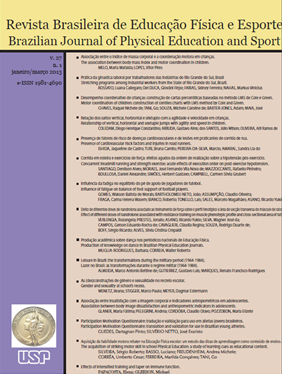Association between body image dissatisfaction and anthropometric indicators in adolescents
DOI:
https://doi.org/10.1590/S1807-55092013000100013Keywords:
Anthropometry, Body image, Skinfolds, Abdominal fat, BMIAbstract
The aim of this study was to evaluate the association between body image dissatisfaction, body mass index (BMI), body adiposity and abdominal obesity in adolescents. A total of 637 adolescent boys and girls (11-17 years) participated. Measures of body weight, height, waist circumference, triceps and medial calf skinfold thickness and, body image were collected. BMI, abdominal obesity and body adiposity were used as references in relation to the outcome. The prevalence of body image dissatisfaction was 60% (boys = 54.3%; girls = 65.2%, p < 0.05). Boys with a low BMI and abdominal obesity presented a 4.31 and 4.93 times higher probability of body image dissatisfaction, respectively. In girls, the probability of body dissatisfaction was 6.81 and 1.95 times higher among those with a high BMI and high body adiposity, respectively. Low BMI and abdominal obesity were associated with body image dissatisfaction in boys, whereas in girls an association was observed with high BMI and high body adiposity.Downloads
Download data is not yet available.
Downloads
Published
2013-03-01
Issue
Section
Pedagógica e Comportamental
License
Todo o conteúdo da revista, exceto onde está identificado, está licenciado sob uma Licença Creative Commons (CC-BY)
How to Cite
Glaner, M. F., Pelegrini, A., Cordoba, C. O., & Pozzobon, M. E. (2013). Association between body image dissatisfaction and anthropometric indicators in adolescents . Brazilian Journal of Physical Education and Sport, 27(1), 129-136. https://doi.org/10.1590/S1807-55092013000100013


